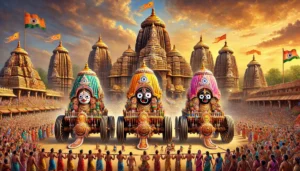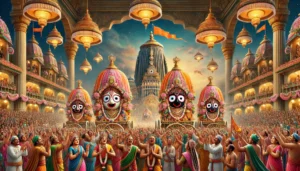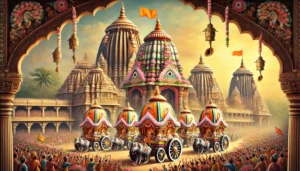
Why Lord Jagannath visits Gundicha Temple
The Sacred Legends of Gundicha Temple: Mythology and Mysticism
The Gundicha Temple, nestled in the sacred city of Puri, Odisha, holds immense mythological and spiritual significance in the Jagannath tradition. It is closely associated with the world-renowned Rath Yatra, during which Lord Jagannath, along with His siblings Balabhadra and Subhadra, leaves the main Jagannath Temple to reside at the Gundicha Temple for a period of seven days. This temple is also referred to as the “Garden House of Jagannath” and is believed to be the birthplace of the deity’s wooden idol.
Mythological Origins
According to legend, Gundicha Temple is named after Queen Gundicha, the consort of King Indradyumna, the legendary ruler of Malwa and the great devotee who established the Jagannath Temple. It is believed that Queen Gundicha was an ardent worshipper of Lord Jagannath and played a pivotal role in the temple’s consecration. Moved by her devotion, Lord Jagannath promised to visit her home once a year. This led to the tradition of the annual Rath Yatra, where the deity leaves His main temple and resides at Gundicha Temple for a week.
Another prominent belief states that Gundicha Temple is the symbolic birthplace of Lord Jagannath. The deities of Jagannath, Balabhadra, and Subhadra are carved from sacred neem wood, a practice rooted in the legend of Vishwakarma, the divine architect, who sculpted the deities within this temple before they were installed at the Jagannath Temple. Thus, the temple is considered the sanctum where the divine idols first took form.
The Divine Journey: Rath Yatra and Stay at Gundicha Temple
The Rath Yatra, or Chariot Festival, is an annual event during which Lord Jagannath, Balabhadra, and Subhadra travel in grand chariots from the Jagannath Temple to the Gundicha Temple, a journey that spans about 3 kilometers. This festival symbolizes the return of Lord Jagannath to His birthplace and the fulfillment of His promise to Queen Gundicha.
After reaching Gundicha Temple, the deities reside there for seven days, during which special rituals and offerings are performed. On the ninth day, they embark on the Bahuda Yatra (Return Journey) back to the Jagannath Temple, stopping at the Mausi Maa Temple on the way to accept an offering of Poda Pitha, a traditional sweet delicacy.
Table of Contents

Why Lord Jagannath visits Gundicha Temple
Spiritual Significance
The Gundicha Temple is considered an integral part of Jagannath consciousness, as it represents a period of divine retreat and rejuvenation for the deity. Devotees believe that visiting the temple during the Rath Yatra period grants them immense spiritual merit, as they witness the Lord in a state of blissful leisure.
Another spiritual interpretation connects the journey of Lord Jagannath to the Gundicha Temple with the concept of Krishna’s Vrindavan pastimes. Devotees see it as a metaphorical return of Krishna (Jagannath) to His childhood home, much like how Krishna left Mathura to revisit Vrindavan, where He spent His youthful days with the gopis and cowherds.
Architectural Features
The Gundicha Temple is a simple yet elegant structure built in the traditional Kalinga architectural style. Unlike the grandiose Jagannath Temple, it exudes serenity and is surrounded by lush gardens, reinforcing its identity as the “Garden House of Jagannath.” The temple is largely unoccupied for most of the year, except during the Rath Yatra when it transforms into a hub of devotion and festivities.
Rituals and Festivities at Gundicha Temple
During the seven-day stay of the deities at the Gundicha Temple, a series of elaborate rituals take place. Special offerings known as “Mahaprasad” are prepared and distributed among the devotees. The temple priests perform daily arati and bhog offerings, invoking the presence of the divine. Devotional songs and cultural performances dedicated to Lord Jagannath enhance the spiritual ambiance of the temple premises.
Additionally, the period of the Lord’s stay at the Gundicha Temple is considered auspicious for devotees to engage in charity and penance. Many pilgrims observe fasts and chant the holy names of the Lord, seeking spiritual elevation and divine blessings.
Legends Associated with the Rath Yatra
Several legends further amplify the significance of the Rath Yatra and the Gundicha Temple. One such tale describes how Goddess Lakshmi, the consort of Lord Jagannath, is displeased with His departure to the Gundicha Temple and decides to express Her anger by staging the Hera Panchami ritual. In this unique tradition, Lakshmi visits the Gundicha Temple in a grand procession and playfully damages a portion of Lord Jagannath’s chariot as a mark of Her displeasure.
Another belief suggests that Lord Jagannath’s journey represents His visit to the home of His devotees, reaffirming the idea that the Lord is accessible to all, regardless of social status or background.

Why Lord Jagannath visits Gundicha Temple
Conclusion
The mythology of the Gundicha Temple is deeply intertwined with the Jagannath tradition, symbolizing devotion, divine movement, and the cycle of departure and return. It serves as a reminder of the Lord’s eternal promise to His devotees and continues to be a sacred site where millions seek blessings, spiritual fulfillment, and a connection to the divine journey of Jagannath. The annual Rath Yatra and the temple’s mythological significance make it an essential pilgrimage destination for followers of Sanatan Dharma. The legends, rituals, and traditions associated with the temple continue to inspire and attract devotees from across the world, keeping the vibrant legacy of Lord Jagannath alive through generations.
FAQs on the Mythology of Gundicha Temple
The Abode of Lord Jagannath’s Divine Journey
- What is the significance of Gundicha Temple in Jagannath mythology?
Gundicha Temple is one of the most sacred sites associated with Lord Jagannath in Puri. It is believed to be the Garden House of the deity, where he and his siblings, Balabhadra and Subhadra, stay for seven days during the grand festival of Rath Yatra. According to legend, the temple is the birthplace of the wooden deities of Jagannath, making it an essential part of their divine journey.
- Why is Gundicha Temple called the ‘Mausi Maa Temple’?
Gundicha Temple is sometimes referred to as the Mausi Maa Temple because, in mythology, Gundicha Devi, the queen of King Indradyumna, is considered an aunt-like figure who played a crucial role in the establishment of the temple. Additionally, Lord Jagannath is offered a special sweet dish called Poda Pitha during his stay, which is believed to be prepared by his ‘Mausi’ (maternal aunt).
- What is the mythological story behind Lord Jagannath’s journey to Gundicha Temple?
The legend states that Lord Jagannath, along with Balabhadra and Subhadra, leaves his main temple in Puri and journeys to Gundicha Temple, symbolizing a divine visit to his birthplace and maternal home. This event is believed to signify the love and longing between the Lord and his devotees.
- How is Gundicha Temple connected to the Rath Yatra?
Gundicha Temple is the destination of the world-famous Rath Yatra (Chariot Festival). Every year, the deities are placed on three massive, elaborately decorated chariots and pulled by thousands of devotees from the Jagannath Temple to Gundicha Temple. They stay at Gundicha Temple for a week before returning via the Bahuda Yatra (Return Journey).
- What rituals are performed at Gundicha Temple during Rath Yatra?
During the seven-day stay, the deities are offered daily bhog (sacred food offerings), and various rituals take place, including:
- Adapa Mandap Darshan: Devotees can have a rare and intimate glimpse of Lord Jagannath in a relaxed state.
- Hera Panchami: A unique ritual where Goddess Lakshmi ‘visits’ the temple, upset that Lord Jagannath left her behind.
- Maha Prasad Offering: Special delicacies are prepared and offered to the deities before being distributed among devotees.
6. What is the significance of the return journey, Bahuda Yatra?
After the seven-day stay at Gundicha Temple, Lord Jagannath and his siblings return to the main Jagannath Temple in a grand procession called Bahuda Yatra. During this return, the chariots make a stop at the Mausima (Aunt’s) Temple, where the deities are offered Poda Pitha, a traditional Odia dish.
- Is there any spiritual symbolism behind Lord Jagannath’s stay at Gundicha Temple?
Yes, the journey to Gundicha Temple symbolizes:
- The Lord’s divine love and equal acceptance of all his devotees.
- A break from royal grandeur to embrace a more simple, humble abode.
- A deep spiritual retreat, representing detachment from materialism and an invitation to reconnect with divine love.
8. What is Indradyumna’s connection to Gundicha Temple?
King Indradyumna, the legendary ruler of Malwa, is credited with the construction of both the Jagannath Temple and Gundicha Temple. The temple is named after his queen, Gundicha Devi, who was a great devotee of Lord Jagannath and instrumental in making the temple a sacred space.
- Why is Gundicha Temple empty for most of the year?
Unlike the Jagannath Temple, Gundicha Temple remains unoccupied for most of the year, except during the Rath Yatra festival. It is specially cleaned and sanctified before the arrival of Lord Jagannath and his siblings.
- What is the architectural style of Gundicha Temple?
The temple follows the Kalinga architectural style, made of light-colored sandstone. The sanctum (garbhagriha) houses a platform where the deities are placed during their stay. The temple is surrounded by a large garden, adding to its serenity.
- What is ‘Adapa Mandapa Darshan’ and why is it special?
Adapa Mandapa Darshan refers to the rare opportunity for devotees to see Lord Jagannath, Balabhadra, and Subhadra in a more relaxed posture inside Gundicha Temple. Unlike the Jagannath Temple, where the deities are placed on a high platform, at Gundicha Temple, devotees can have a closer darshan (viewing).
- What happens to the temple after Rath Yatra ends?
After the deities return to Jagannath Temple, Gundicha Temple is thoroughly cleaned and remains mostly empty until the next Rath Yatra. However, occasional rituals and maintenance activities are performed throughout the year.
- Can visitors enter Gundicha Temple when the deities are not there?
Yes, Gundicha Temple is open to visitors, but it remains a quiet and less-crowded space compared to the Jagannath Temple. Devotees visit it to experience its spiritual aura and to see the Adapa Mandapa, where the deities rest during Rath Yatra.
- What are some interesting lesser-known facts about Gundicha Temple?
- It is also called ‘Garden House of Jagannath’ due to its lush green surroundings.
- Unlike the Jagannath Temple, which is always bustling, Gundicha Temple offers a peaceful and meditative atmosphere.
- The temple has no permanent idol worship, as it serves only as a temporary residence for Lord Jagannath during Rath Yatra.
- Some legends suggest that this is where the daru (sacred wood) for the first idols of Jagannath, Balabhadra, and Subhadra was originally carved.
15. How can devotees participate in the rituals of Gundicha Temple?
Devotees can witness the grand Rath Yatra and visit the temple during the festival. While inside the temple, they can offer prayers, take part in kirtans (devotional songs), and receive Mahaprasad.
Summary
The Gundicha Temple, located in Puri, Odisha, holds immense significance in Jagannath culture and mythology. It is believed to be the birthplace of Lord Jagannath’s wooden idols and serves as his temporary abode during the annual Rath Yatra. According to legend, Queen Gundicha, the devout wife of King Indradyumna, requested Lord Jagannath to visit her home once a year. Fulfilling her wish, the deity, along with his siblings Balabhadra and Subhadra, travels from the Jagannath Temple to Gundicha Temple, staying there for seven days before returning.
This sacred journey symbolizes the divine leela (pastime) of Lord Jagannath, reinforcing themes of devotion, hospitality, and spiritual renewal. The temple itself is regarded as the Vrindavan of Puri, radiating a tranquil and mystical aura during the Rath Yatra. The mythology of Gundicha Temple highlights the deep-rooted traditions and divine narratives that continue to inspire millions of devotees.
Unlock the Ancient Wisdom of Sanatan Dharma – Join Us on YouTube!
👉 Subscribe now to Prachin Sanatan Dharma and embark on a journey of enlightenment.
Explore timeless teachings, spiritual insights, and cultural richness on our YouTube channel, Prachin Sanatan Dharma. Dive deep into the essence of Sanatan Dharma through captivating videos that inspire and educate.
Related Articles
- Restful Nights: Ayurvedic Remedies and Traditional Indian Practices to Overcome Insomnia and Late-Night Habits
- The Tridevi: Lakshmi, Saraswati, and Parvati – Their Roles and Powers
- “Divine Creatures of Ancient Indian Scriptures: Exploring the Role of Animals in the Vedas, Puranas, and Mahabharata”
- Nature and Spirituality: Exploring the Sacred Essence of the Himalayas, Ganga, and Other Natural Wonders”
- “Reviving the Gurukul System: Relevance and Lessons for Modern Education”
- “Exploring Greek and Indian Mythology: Similarities Between Greek and Indian Mythology “
- “Embracing Sattvic Living: Harmonizing Mind, Body, and Soul Through Food and Lifestyle”
- “Charity and Prosperity: Exploring the Concept of Daan and Its Financial Relevance in Modern Life”
- How to Build an Eco-Friendly Home Inspired by Vastu Shastra
- Comparison of Ancient and Modern Sports: How Traditional Sports Have Influenced Contemporary Games
- “Timeless Lessons from Ancient Tales: Linking Samudra Manthan and Ganga’s Descent to Modern Ecological Challenges”
- “Reviving Sanskrit: How AI is Preserving Ancient Languages for the Future”
- “Mathura: The Sacred Land of Lord Krishna’s Divine Leelas”
- Investing for Future Generations: Lessons from Indian Traditions on Legacy Building and Wealth Preservation
- “Ancient Indian Wisdom: Timeless Lessons for Tackling Today’s Climate Crisis”
- “Artificial Intelligence and Spirituality: Transforming Ancient Practices for the Modern World”
- “Gold and Real Estate in India: Timeless Assets Shaping Financial Strategies”
- Tradition Meets Innovation: The Evolution of Technology in Hindu Rituals
- End-of-World Myths: Exploring Kali Yuga in Hinduism and Ragnarök in Norse Mythology
- Garuda, Pegasus, and Dragons: The Universal Ties of Mythical Beasts Across Cultures
- “Ancient Vimanas: Mythical Flying Machines or Evidence of Advanced Technology?”
- Time Travel in Hindu Mythology: The Fascinating Tales of Kakudmi and King Raivata
- “Divine Feminine Power in Hindu Mythology: The Legends of Durga, Saraswati, and Lakshmi”
- “Divine Beings of Sanatan Dharma: The Spiritual Significance of Sacred Animals in Hinduism”
- “Symbolism in Mythological Art: Unlocking Hidden Meanings in Ancient Temple Carvings”
- “Exploring Technological Advancements in Ancient India and Civilizations: Vimana, Metallurgy, & Water Management systems”
- Unveiling the Mysteries: Ancient Temples of Sanatan Dharma , Mysterious Temples of India
- “The Scientific Knowledge of Sanatan Dharma: Ancient Wisdom Meets Modern Science”
- Ancient Indian Sports and Games: Celebrating a Legacy of Skill, Strength & Strategy”
- “Exploring the Cosmic Link: The Connection Between Astronomy and Vedic Astrology”
- The Power of Sanskrit: Unlocking the Divine Language of the Gods
- “The End of Kaliyuga: A Sanatan Insight into the World’s Final Chapter”
- Explore more articles on Prachin Sanatan Yuga.
Why Lord Jagannath visits Gundicha Temple Why Lord Jagannath visits Gundicha Temple Why Lord Jagannath visits Gundicha Temple Why Lord Jagannath visits Gundicha Temple Why Lord Jagannath visits Gundicha Temple Why Lord Jagannath visits Gundicha Temple Why Lord Jagannath visits Gundicha Temple Why Lord Jagannath visits Gundicha Temple Why Lord Jagannath visits Gundicha Temple Why Lord Jagannath visits Gundicha Temple
Why Lord Jagannath visits Gundicha Temple Why Lord Jagannath visits Gundicha Temple Why Lord Jagannath visits Gundicha Temple Why Lord Jagannath visits Gundicha Temple Why Lord Jagannath visits Gundicha Temple Why Lord Jagannath visits Gundicha Temple Why Lord Jagannath visits Gundicha Temple Why Lord Jagannath visits Gundicha Temple Why Lord Jagannath visits Gundicha Temple Why Lord Jagannath visits Gundicha Temple
Why Lord Jagannath visits Gundicha Temple Why Lord Jagannath visits Gundicha Temple Why Lord Jagannath visits Gundicha Temple Why Lord Jagannath visits Gundicha Temple Why Lord Jagannath visits Gundicha Temple Why Lord Jagannath visits Gundicha Temple Why Lord Jagannath visits Gundicha Temple Why Lord Jagannath visits Gundicha Temple Why Lord Jagannath visits Gundicha Temple Why Lord Jagannath visits Gundicha Temple
